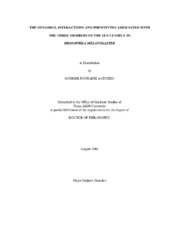| dc.description.abstract | It has been proposed that the various 14-3-3 isotypes and isoforms present in all eukaryotes are largely functionally equivalent. However, this is not consistent with the conservation of multiple isoforms and isotypes, especially in vertebrates with seven 14-3-3 encoding genes and nine isotypes. The hypothesis tested in this thesis is that both isoform-specific and overlapping functions are likely mediated through tissue specific expression, colocalization and dimerization of 14-3-3 proteins occur in vivo. Drosophila melanogaster was selected because it offers a simple, but representative system to study these proteins functionally. This thesis focuses primarily on D14-3-3?, although the expression pattern and phenotypes associated with all three Drosophila 14-3-3s were determined. I first determined the expression pattern of the three different 14-3-3 isotypes (leoI, leoII and D14-3-3?) and described developmental phenotypes associated with mutations in 14-3-3 isotypes in Drosophila. I found that there is partial redundancy with respect to lethality. Both LEO and D14-3-3? appear required for normal germ-line and somatic gonadal development. However, they do not appear to be functionally equivalent with respect to this phenotype since LEO is unable to compensate for the loss of D14-3-3?. I also determined that D14-3-3? mutants have unique phenotypes including deficits in adult cross-vein formation and rapid habituation to olfactory and footshock stimuli. To further understand the unique role that D14-3-3? plays in the adult CNS, I mapped the areas in the brain involved in olfactory and footshock habituation. I found that although the mushroom bodies (MBs) are necessary to inhibit premature habituation such as that exhibited by D14-3-3? mutants, D14-3-3? expression specifically in the MBs is not sufficient to rescue premature habituation. Although the loss of either LEO or D14-3-3? appears to cause a deficit in olfactory associative learning, premature habituation is the cause of the deficit seen in D14-3-3? mutants. As leo mutants do not exhibit a premature habituation phenotype, it appears that within the MBs LEO and D14-3-3? are not functionally equivalent. Therefore, the data supports the hypothesis that 14-3-3s have functional specificity and redundancy likely to represent use of homo and heterodimers in different processes within the tissues of an organism. | en |


